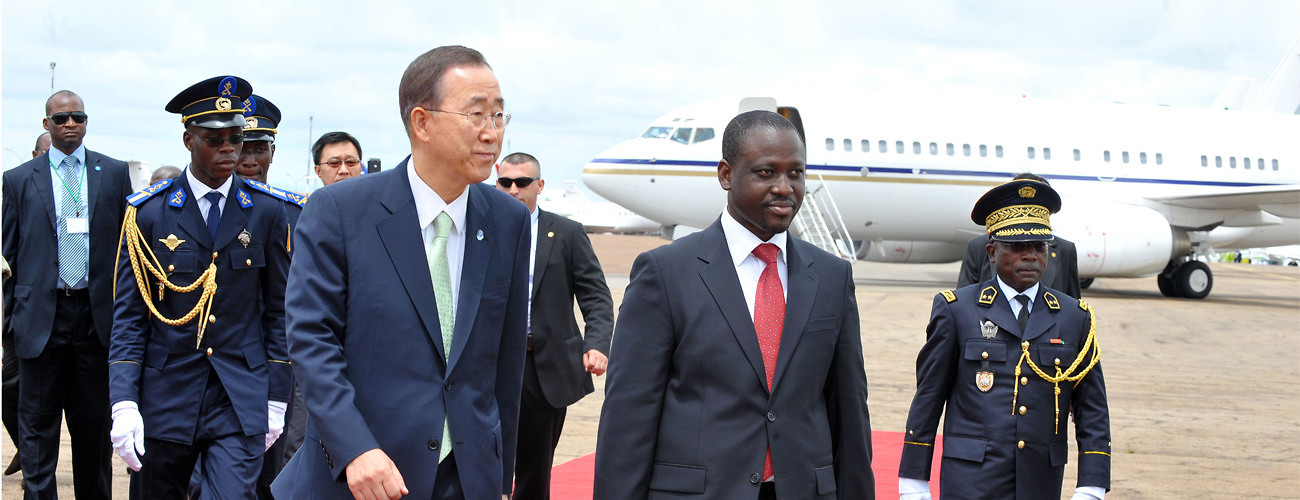UN Secretary-General Ban Ki-moon (left) is received by Guillaume Soro, Prime Minister of Côte d'Ivoire, at Yamoussoukro airport. May 21, 2011. (UN Photo/Basile Zoma)
Over the past few years there has been a resurgence of interest in employing preventive tools to thwart the outbreak and escalation of violent conflict. This paper looks at the state of and challenges ahead for preventive diplomacy in four different regions of the world: Africa, Latin America, Southeast Asia, and Northeast Asia.
As Francesco Mancini, IPI’s Senior Director of Research, noted in the paper’s introduction, the instruments of preventive diplomacy are more cost-effective than the deployment of a peacekeeping operation and can avert the loss of innocent lives and prevent the devastating consequences produced by internal displacement and economic upheaval. It remains a key priority for UN Secretary-General Ban Ki-moon, who has called it “one of the smartest investments [the UN] can make.”
Additionally, Mr. Mancini wrote that the preventive diplomacy field has become increasingly crowded, and now comprises a vast array of international, national, and local actors. Furthermore, this new wave of prevention is no longer primarily externally driven. Local actors have become more proactive in expanding their roles in support of preventive initiatives within their own countries.
Contents:
Introduction
by Francesco Mancini, International Peace Institute
Preventive Diplomacy in Africa: Adapting to New Realities
by Fabienne Hara, International Crisis Group
Ms Hara writes that with regional actors and bodies taking an increasing role in conflict prevention in Africa, the UN has lost ground in the continent in the area of conflict prevention. She offers key observations and recommendations going forward, concluding that the UN still has an important role to play, and it should redefine and reassert the added value, as well as peace and security responsibilities of the various parts of the UN system, to the current division of labor among multilateral actors, while improving the quality of strategic dialogue and coordination with key regional actors.
Optimizing Preventive-Diplomacy Tools: A Latin American Perspective
by Sandra Borda, Universidad de Los Andes
Ms. Borda writes that despite the relative absence of armed interstate conflict in Latin America, many potential conflict dyads exist, mainly from unresolved border conflicts. Therefore, it would be imprudent to ignore potential conflict scenarios between various states. She analyzes the three main actors involved in preventive diplomacy in the region – multilateral bodies, nation-states, and civil society organizations, and concludes with a set of eleven lessons and recommendations.
Preventive Diplomacy in Southeast Asia: Redefining the ASEAN Way
by Jim Della-Giacoma, International Crisis Group
Mr. Della-Giacoma writes that though there has been no “large-scale” war in the region since ASEAN’s formation in 1967, many lingering conflicts exist. He focuses on the role that ASEAN has played and can play in the future, along with the associated challenges, using the Thailand-Cambodia border dispute as an example.
Preventive Diplomacy on the Korean Peninsula: What Role for the United Nations?
by Leon Sigal, Social Science Research Council
Mr. Sigal looks at the security challenges of Northeast Asia. He reviews the security developments of the past few years on the Korean peninsula, and asks what role the UN can play in preventive diplomacy in the region. Despite the parties seemingly incapable of resolving their differences, the UN, through its various agencies and bodies, can push them towards constructive engagement.
This publication also includes a reprint of Preventive Diplomacy: Delivering Results, the August 2011 report of the Secretary-General, and the statement by the President of the Security Council on the Secretary-General’s report.








